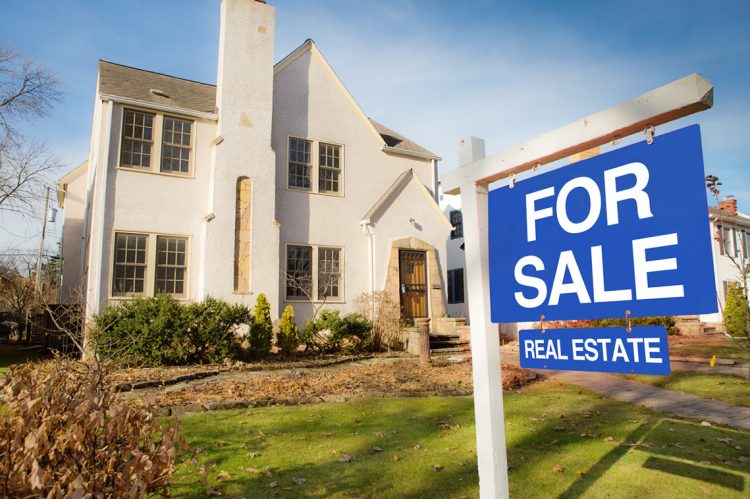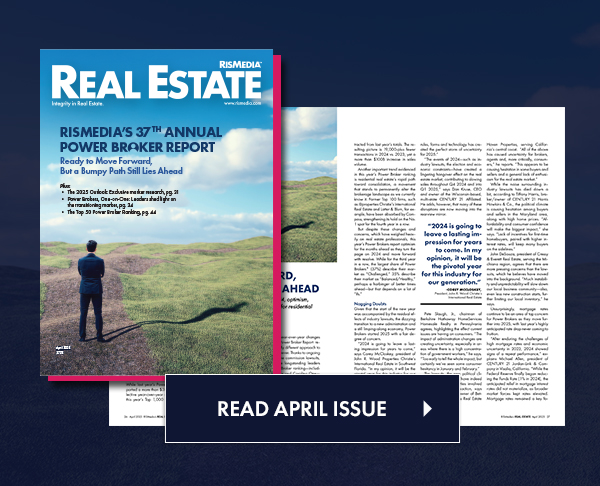Existing-home sales surged 14.5% from January to a seasonally adjusted annual rate of 4.58 million in February—its largest monthly percentage increase since July of 2020, according to the National Association of REALTORS®’ (NAR) most recent existing-home sales report.
While year-over-year sales fell 22.6%, month-over-month sales rose in all four major U.S. regions, and all regions posted YoY declines. NAR’s latest data shows the overall jump reversed a 12-month decrease.
Key data points:
- Total housing inventory was at 980,000 units, identical to January and up 15.3% from one year ago (850,000). Unsold inventory sits at a 2.6-month supply at the current sales pace, down 10.3% from January but up from 1.7 months last year.
- The median existing-home price for all housing types was $363,000, a decline of 0.2% from last year ($363,700). This ends a streak of 131 consecutive months of YoY increases, the longest on record.
- Properties typically remained on the market for 34 days, up from 33 days in January and 18 days last year. Of homes sold, 57% were on the market for less than a month.
- First-time buyers were responsible for 27% of sales, down from 31% in January and 29% one year ago.
- All-cash sales accounted for 28% of transactions, down from 29% in January but up from 25% last year. Individual investors, or second-home buyers, who make up many cash sales, purchased 18% of homes, up from 16% in January but down from 19% one year ago.
- Distressed sales—foreclosures and short sales—represented 2% of sales, nearly identical to last month and one year ago.
Single-family and condo/co-op sales:
- Single-family home sales soared to 4.14 million, up 15.3% from 3.59 million in January but down 21.4% from the previous year. The median existing single-family home price was $367,500, down 0.7% from last year.
- Existing condominium and co-op sales were at 440,000 units, up from 410,000 in January but down 32.3% from one year ago. The median existing condo price was $321,000, an annual increase of 2.5%.
Regional breakdown:
- Sales in the Northeast improved 4% from January to an annual rate of 520,000, down 25.7% from last year. The median price was $366,100, down 4.5% from the previous year.
- In the Midwest, sales grew 13.5% from January to 1.09 million, declining 18.7% from one year ago. The median price was $261,200, up 5% from last year.
- Sales in the South rebounded 15.9% from January to 2.11 million, a 21.3% decrease from the prior year. The median price was $342,000, an increase of 2.7% from one year ago.
- In the West, sales rocketed 19.4% from January to 860,000, down 28.3% from the previous year. The median price was $541,100, down 5.6% from last year.
Major takeaways:
“Conscious of changing mortgage rates, homebuyers are taking advantage of any rate declines,” said NAR Chief Economist Lawrence Yun. “Moreover, we’re seeing stronger sales gains in areas where home prices are decreasing and the local economies are adding jobs.”
Yun added, “Inventory levels are still at historic lows. Consequently, multiple offers are returning on a good number of properties.”
“Owning a home provides a path to long-term financial security and is a vehicle by which to transfer wealth to future generations,” said NAR President Kenny Parcell, broker/owner of Equity Real Estate Utah. “REALTORS® deliver expert guidance, objectivity and professionalism to consumers during the complex process of purchasing a home.”
Bright MLS Chief Economist Dr. Lisa Sturtevant commented that:
“The number of home sales surged in February, reflecting activity in January when falling mortgage rates enticed buyers back into the market to make offers on homes. There was a total of 4.580 million home sales on a seasonally adjusted annual basis, which is a 14.5% jump from a month ago. Despite the increase, sales of existing homes are down more than 30% from a year ago and remain below pre-pandemic levels.
“Home prices fell in February, the first year-over-year decline in the national median home price in more than two decades. Higher mortgage rates have eroded buyers’ purchasing power, and prices have taken a hit. But the drop in price is modest, and a lack of supply continues to prop up prices in many housing markets.
“At the beginning of the year, most signs pointed to a robust rebound and a busy spring housing market. However, economic whiplash has led to greater uncertainty about the spring market. Mortgage rates rose in February as the Federal Reserve signaled more rate hikes to come. But the recent banking crises could lead to a pause on rate hikes and to a reversal in mortgage rates. Prospective homebuyers will be watching rates closely, and we may see volatility in weekly contract activity as people react to ups-and-downs in mortgage rates.”
Realtor.com® Economic Data Analyst Hannah Jones commented that:
“Sales of existing homes gained significant ground in February, increasing 14.5% to an annual rate of 4.58 million homes as buyers flocked to the market in response to slightly lower mortgage rates. This month’s surge reversed a 12-month slide in existing-home sales, increasing by the largest month-over-month margin since July 2020. Pent up housing demand continues to be sensitive to mortgage rate changes as potential buyers take advantage of any improvement in affordability. Sales increased in all four regions month-over-month, ranging from a 4% increase in the Northeast to 19.4% in the West. Despite the month’s progress, existing-home sales are still down between 18.7% and 28.3% year-over-year in all four regions.
“Home sellers are still in a favorable position to cash in on home equity as prices remain elevated compared to last year, but the dwindling buyer pool makes the task more challenging. Home sales remain well below last year’s level, signaling that significant affordability gains must be made before buyers are able to return to the market en masse.
“For-sale inventory is recovering, and fewer buyers are in the market, shifting balance back toward home shoppers. Months supply—the number of months it would take to sell all currently unsold homes at today’s sales pace—fell slightly to 2.6 months, 10.3% lower than in January but up from 1.7 months one year ago. Notably, existing home prices notched a 0.2% decrease in February, the first decrease relative to the previous year in 131 months.
“The spring season is typically accompanied by a thaw in the winter housing market. Historically, both buyer and seller activity picks up as the weather warms and sellers approach the Best Time to Sell, the week that historically sees the best combination of buyer demand, time on market, price and competition. As high prices and elevated mortgage rates continue to stifle buyer activity, this spring’s market is expected to be toned down relative to the last couple of years. However, the housing market remains undersupplied, so well-priced, well-maintained listings are likely to draw buyer attention.”
Ruben Gonzalez, chief economist for Keller Williams, commented that:
“We continue to expect large year-over-year declines in home sales for the first half of this year. We also expect to see year-over-year declines in home prices for the next several months.The recent bank failures are likely to weigh on home sales in coming months despite the recent decline in mortgage rates.
“In the past, banking crises have often corresponded with protracted housing market downturns and declining home prices. They have also precipitated, or resulted from, severe recessions. We suspect these failures will worsen an ongoing recession in the housing market. A swift return to stability will improve the odds of a more modest impact, but it is unlikely we will go unscathed.
“These associations will also complicate Federal Reserve policy discussions. As they weigh price stability against potential credit market turmoil, we may see a notable shift in tone from the Federal Reserve. Most economic barometers have continued to show strength, but bank failures of this magnitude have rarely left the economy unaffected, and it’s too soon to know their full impact.”
For the full report, click here.













